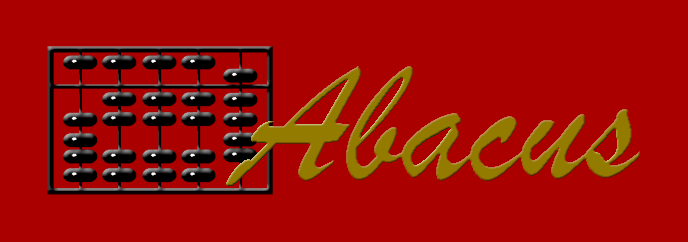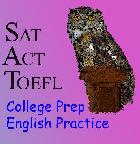
Services
- *** NEW ***
- Online Education
- What is Correct English?
- Acing the SAT
- Homeschool Classes
- Grammar Resources
- SAT Grammar Errors
Site Map
- AES Home
- Featured Resource
- Acing the SAT
- Education Journal
- Grammar Playsheets
- Grammar Resources
- Vocabulary tips
- Vocabulary Quiz
- Software
- Online SAT Resources
- SAT Grammar Errors
- Books on the New SAT
- Vocabulary Books
- Vocabulary List
- Vocabulary Crosswords
- Homeschooling
- Homeschooling
- Homeschooling Classes
- AP exam preparaion
- Homeschooling Books
- Homeschool on the Web
- Homeschooler Central
- Children's books
- The Wind in the Willows
- The Golden Age
- Language Reference
- Common Errors
- Subject/Verb mismatch
- Number (singular/plural)
- Case, declension
- Misplaced Modifiers
- Metaphors
- Mixed Metaphors
- Confused Verbs
- Sentence Fragments
- Run-on Sentences
- Parts of Speech
- Verbs
- Nouns, Pronouns
- Prepositions
- Adjectives
- Online Education
- Studying Online
- Online Higher Education
- Writing Class Online
- Online degrees
- Accredited degrees
- Recommended reading
- Children's books
- Cat Flinging
- Motorscooter Solution
- Wistful Vistas
- Thailand Escape
- Contact us
- Graded Links
Critical Thinking and Mind Control
-- K.T.The words, “Tai-kwon-do”, then “U-S-A”, then “Ko-re-a” rang out from the lips of a dozen or so children ages six to nine in accompaniment to a right-left-right punching combination. Focus was a bit lacking, there was little hip involvement, and some of the participants looked more than a little awkward; but the enthusiasm was ever so present as they shouted the words at the top of their lungs.
Clearly the meaning of the words was not the point of the exercise. Far more poignant to me than any words they might be shouting was that very fact -- the fact that the meaning of the words was not the point. “Veg-e-mite” or “eggs-and-Spam” would have done just as well. This is frightening. Particularly in the days since 9-11, frustration and fear have inspired many forms of patriotic fervor, one particular flavor of which I was seeing that day in the Tai Kwon Do studio that my eight-year-old daughter and I were visiting in hopes of finding an activity she would like. I felt significant relief in discovering that she was no more inspired by the class than I.
In their gis, the uniform of the martial art, and sporting a variety of coveted stripes on their belts signifying ranking and authority, their response to each directive was a reflexive "Sir!" with all the fealty and implication of absolute reverence for authority that that form of address implies. The scene brought to mind not so much American patriotism as the memorable ancient black and white images of a boy beating a drum and rows upon rows of smartly uniformed youth chanting in unison in Leni Riefenstahl's "Triumph of the Will", the great Nazi propaganda film for which the Nuremberg rallies were largely staged. About the same age as my daughter, the boys and girls of the “Hitler Jugend” and “Bund Deutscher Mädel” who participated there, beating their drums, singing their songs, chanting their slogans, gave no more thought to the larger picture than did these incipient martial artists before me propelling their tiny fists upon command into imaginary adversaries.
In an effort to transcend mere training and provide an education, our California educational system has, in a move of perhaps uncharacteristic circumspection, attempted to include in every class a substantial “critical thinking” component. Each proposed new course outline must contain such a component consisting, at the very least, of outside readings in primary or secondary sources which can put the dictates of the textbook into perspective by providing alternative points of view.
I rejected as inappropriate and probably very impolite the impulse to ask the presiding Tai kwon do master about the critical thinking component of his class and whether similarly jingoistic chants, altered to fit local allegiances, would be used by Tai kwon do studios in other countries. Such practices certainly fit well into the mind-homogenizing rhetoric of North Korea and the People's Republic of China where rhythmic chanted government endorsed slogans are compulsory everyday fare. It also occurred to me that if other words were substituted in that three punch combination, such as “Slo-bo-dan,” “Mu-ga-be,” or even “O-sam-a” that these children would comfortably make the transition without a murmur.
In the past year many people have wondered at the mindset that could inspire persons to take their own lives in an act whose purpose is to bring misery, suffering, and death to others. In whose philosophy or creed is it taught that eternal rewards await a person who has performed such an act? The mystery baffles many and engenders much rancorous suspicion and distrust. Whatever the doctrine is that condones and legitimizes such actions, one very clear conclusion is unavoidable: The critical thinking component is lacking!
Clearly a very powerful force is brought to bear when fervor of any sort takes hold or is instilled and when act, reflex, and performance are divorced from perspicacity and conscience. Military training the world over attempts to create a reflexive response through constant repetition against such time that a soldier will be faced with taking lives. This ensures that any impulse to think will be overwhelmed by the intended automatic programmed response. Whether the “divine wind” of the kamikaze or the religious zeal of the Al Queda terrorist, it is the training methodology that is responsible for removing the critical thinking component from the equation and it is the absence of that component that makes possible the acts that we have seen replayed again and again so vividly. The underlying ideology is no longer relevant once the slogan is chanted and the critical mind has been turned off. Ideologues of any stripe who have relinquished the practice of critical thinking, including patriots, make good cannon fodder - and good suicide terrorists.
How then can we miss seeing the fact that our response to terrorism has largely been to assume a stance of patriotism, rallying in unguarded support of our particular nation, creed, or whatever sociological division we identify with and that we are commonly omitting the all-important critical thinking factor? Is this response not supporting exactly that mindset that is responsible for such dastardly acts? Indeed, shouldn't our response to such acts be quite the opposite, to vilify worldwide the practices of rote indoctrination, state controlled media, and mindless flag waving as being beneath the dignity and responsibility of conscientious sentient beings capable of sagacious, rational thought? And should we not do this by example?
After looking into a number of martial arts schools with very similar procedures with my daughter, we found an Aikido class with a very positive atmosphere and an enlightened and inspiring instructor. Some lengthy discussion in our homeschooling family resulted from the experience, particularly on the question of how best to teach critical thinking. All appreciated with hilarity the incongruity of the militaristic rote approach we'd seen in the Tai kwon do class with students responding “Yes Sir! We will practice critical thinking. Sir!” and in Pythonesque brilliance, one student speaking out with “I will not!”
The teaching of critical thinking is simply not suited to mass production education but it has never before been so accessible. When the media of fifty countries are just a mouse-click away and the greatest literature of the past several millennia is free for the download, we in the U.S. and the developed world have an unparalleled opportunity to both practice and share critical thinking and to help make it a norm throughout the world. Will we do that or will we respond to fervor with fervor:
I do no thinking of my own. I bow and toe the line
I shout the words and fly the flag. Your God's no match for mine
 Advanced Writing text for the student with little time and a low boredom threshold
Advanced Writing text for the student with little time and a low boredom threshold